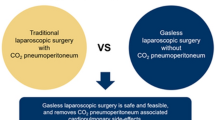Abstract
Background: In a previous clinical study, we showed that the duration and level of pneumoperitoneum are responsible for changes in hepatic function during laparoscopic procedures. These findings encouraged us to evaluate hepatic function during laparoscopy with and without carbon dioxide (CO2) pneumoperitoneum in a clinical setting. Methods: We performed 63 laparoscopic cholecystectomies and 30 non-hepatobiliary laparoscopic procedures in 93 consecutive patients with normal preoperative liver function tests. The anesthesiologic protocol was uniform, using drugs at low hepatic metabolism. We performed laparoscopic cholecystectomies in 43 patients with a pneumoperitoneum; in the remaining 20, we used a gasless technique. We randomized the 43 laparoscopic cholecystectomies into 23 performed with pneumoperitoneum at 14 mmHg and 20 performed at 10 mmHg. All non-hepatobiliary laparoscopic procedures were performed with a pneumoperitoneum of 14 mmHg. The postoperative serologic levels of AST, ALT, and bilirubin, and the prothrombin time were measured at 6, 24, 48, and 72 h. The alterations in the serologic hepatic tests were then related to the type of procedure, its duration, and the level of pneumoperitoneum. Results: The study group was comprised of 93 patients, 39 male and 54 female, with a mean age of 50.5 years (range, 15-74). There were no deaths. There was no morbidity in the pneumoperitoneum group, but there was one case of accidental omental injury during the placement of the abdominal, wall retractor in the gasless group. All patients had postoperative changes in serologic hepatic tests. Slow return to normality occurred 48 or 72 h after the operation. The increase in AST and ALT was statistically significant and correlated to the level and duration of pneumoperitoneum. The serologic change in the gasless group were significantly lower than in the laparoscopic cholecystectomy group with pneumoperitoneum at 14 mmHg. There was no statistically significant difference between the gasless group and the laparoscopic cholecystectomy group with pneumoperitoneum at 10 mmHg. There was a statistically the significant increase in the non-hepatobiliary laparoscopy group over the gasless group, despite the absence of hepatobiliary injuries in the first group. No symptoms were related to these serologic hepatic changes. Conclusions: The gasless technique causes smaller alterations in serological hepatic parameters than pneumoperitoneum at 14 mmHg. By contrast, the gasless technique and low-pressure pneumoperitoneum have the same effect on hepatic function. Therefore, the use of a subcutaneous abdominal wall retractor combined with a low-pressure pneumoperitoneum is recommended for patients with severe hepatic failure. Transaminases
Similar content being viewed by others
Author information
Authors and Affiliations
Additional information
apd: 3 April 2001
Rights and permissions
About this article
Cite this article
Giraudo, G., Brachet Contul, R., Caccetta, M. et al. Gasless laparoscopy could avoid alterations in hepatic function. Surg Endosc 15, 741–746 (2001). https://doi.org/10.1007/s004640090020
Received:
Accepted:
Published:
Issue Date:
DOI: https://doi.org/10.1007/s004640090020




